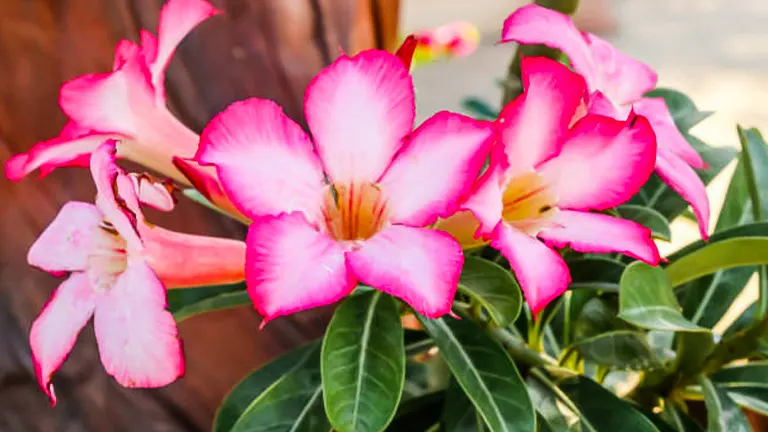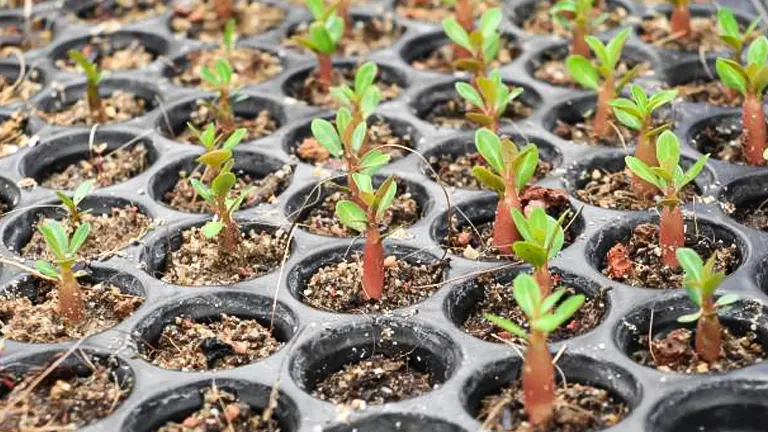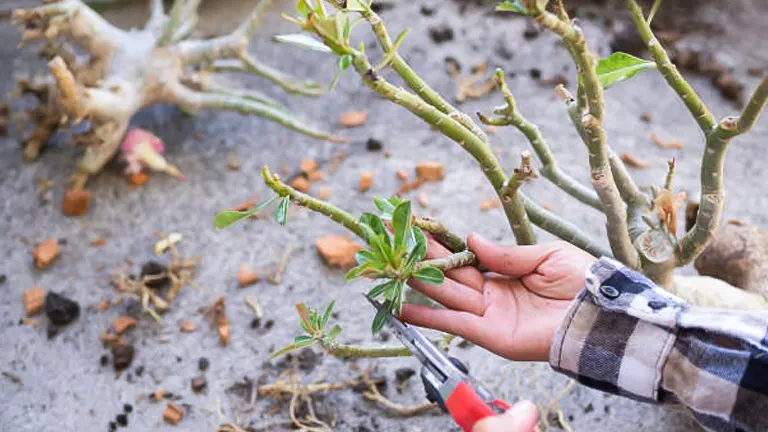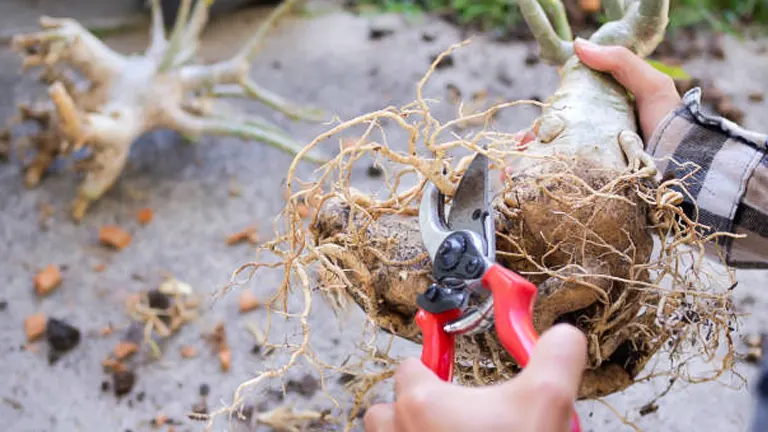How to Grow and Care for Desert Rose: Discover Proven Techniques
- May 7, 2024
- 0 comment
Learn how to grow and care for Desert Rose with our guide on proven techniques for lush, vibrant plants. Dive into the care of the Desert Rose, a plant celebrated for its dramatic blooms and robust form. This guide is perfect for anyone from beginner gardeners to experienced green thumbs.

We’ll detail proven techniques on how to grow and care for the Desert Rose, covering everything from optimal planting conditions to effective watering schedules. With these tips, your Desert Rose will not only survive but flourish, adding a striking element to your garden or indoor space.
Table of Contents
- Understanding Your Desert Rose
- Essential Supplies for Growing Desert Rose
- Planting Techniques
- Creating Optimal Growing Conditions
- Nutrient Requirements and Feeding
- Pruning and Maintenance
- Pest and Disease Management
- Troubleshooting Common Issues
- Propagation Techniques
- Special Considerations for Commercial Growers
- Conclusion
- FAQs
Understanding Your Desert Rose

The Desert Rose, scientifically known as Adenium obesum, is a member of the Apocynaceae family, closely related to both oleander and plumeria. Its defining feature is the caudex, a thickened trunk that serves as a water reservoir, enabling the plant to withstand prolonged dry periods typical of its native habitat. The leaves of the Desert Rose are leathery and spirally arranged, and its tubular flowers are borne in clusters at the branch tips.
Physiological Traits:
- Caudex Size: The size of the caudex can vary significantly between individual plants, often correlating with age and overall health. Mature plants can have caudices that measure up to 12 inches (30 cm) in diameter.
- Leaf Characteristics: The glossy, dark green leaves are typically 5-15 cm long, which helps in minimizing water loss due to their waxy surface.
- Floral Attributes: Flowers range from 2-3 inches (5-7.5 cm) in diameter, displaying a variety of colors with dramatic throat contrasts. These blooms last for several days and can appear throughout warm months if the plant is healthy and the conditions are right.
Growth Patterns: Desert Rose has a slow to moderate growth rate, generally reaching heights of 1-3 feet (30-90 cm). Growth rates are influenced by several factors:
- Light Exposure: Requires full sun for optimal growth and flowering, with at least six hours of direct sunlight daily.
- Watering Frequency: Prefers dry conditions with infrequent but deep watering. Overwatering can lead to root rot and other fungal issues.
- Temperature: Thrives in temperatures ranging from 60°F to 90°F (15°C to 32°C). It is sensitive to cold and should be protected from temperatures below 50°F (10°C).
Varieties: Desert Rose has several cultivars, each distinct in flower color, leaf shape, and growth habit:
- ‘Black Fire’ features deep red to almost black flowers.
- ‘Golden Carrot’ offers a unique golden-orange bloom.
- ‘Snow White’ is prized for its stark white flowers.
Native Habitat and Adaptations: Native to the arid zones of the Arabian Peninsula and Africa, the Desert Rose is adapted to environments where rainfall is scarce and unpredictable. It has developed a remarkable ability to store water and sustain flowering in harsh conditions.
Table of Desert Rose Characteristics
| Characteristic | Description | Value |
|---|---|---|
| Average Height | Mature plant height | 1-3 feet (30-90 cm) |
| Caudex Diameter | Typical caudex width in mature plants | Up to 12 inches (30 cm) |
| Flower Size | Diameter of individual blooms | 2-3 inches (5-7.5 cm) |
| Optimal Temperature Range | Temperature range for healthy growth | 60°F to 90°F (15°C to 32°C) |
| Light Requirements | Daily sunlight needed for optimal health | At least 6 hours of direct sun |
By understanding these detailed aspects of the Desert Rose, enthusiasts can better mimic natural conditions, ensuring the health and vibrancy of their plants. This scientific insight into its growth patterns and physiological makeup helps in nurturing a thriving Desert Rose garden.
Essential Supplies for Growing Desert Rose
Pots and Soil
- Pots: When selecting pots, ensure they have drainage holes to avoid waterlogging, which can lead to root rot. Terracotta pots are ideal due to their porous nature, allowing moisture to evaporate efficiently. This reduces the risk of overwatering. For large plants with mature caudices, pots should be at least 12 inches (30 cm) in diameter to provide ample root space.
- Soil: The soil should mimic the Desert Rose’s natural habitat by being sandy and well-draining. A pre-mixed cactus soil works well, but creating a custom blend can offer more control. Mix one part potting soil with one part coarse sand or perlite. This combination provides aeration, preventing soil compaction and allowing roots to breathe. Aim for a soil pH between 6.0 and 7.5, which is suitable for optimal nutrient uptake.
Gardening Tools
- Pruning Shears: Sharp, sterilized pruning shears are necessary for shaping the Desert Rose. They should be used to trim dead or crossing branches and to encourage more blooms.
- Trowel: A sturdy trowel is essential for repotting or gently loosening soil around the roots. This prevents damaging the delicate caudex during transplantation.
- Gloves: Gardening gloves provide protection, especially since the plant’s sap can be irritating to sensitive skin.
Fertilizers and Nutrients
- Balanced Fertilizers: A balanced, slow-release fertilizer with an NPK ratio of around 10-10-10 is ideal for general maintenance. Fertilizers formulated for cacti and succulents often contain micronutrients that are beneficial for the plant.
- Phosphorus and Potassium-Rich Fertilizers: For flowering, use a fertilizer high in phosphorus and potassium with a reduced nitrogen content (such as a 5-10-10 or 3-8-8 ratio). Nitrogen encourages leafy growth, while phosphorus and potassium stimulate blooms and root health.
- Feeding Schedule: Fertilize every 4-6 weeks during the growing season (spring to early fall). Avoid fertilizing during winter when the plant’s growth slows down.
Table of Essential Supplies
| Supply Type | Recommended Specifications | Purpose |
|---|---|---|
| Pot | Terracotta or ceramic with drainage holes | Prevent waterlogging and root rot |
| Soil Mix | Cactus soil or mix of potting soil, sand, perlite | Provides drainage, prevents compaction |
| Pruning Shears | Sterilized, sharp pruning shears | For shaping and encouraging blooming |
| Trowel | Wide, sturdy with comfortable handle | For repotting and loosening soil |
| Gloves | Durable gardening gloves | Protect hands from sap irritation |
| Fertilizer | Balanced, slow-release (10-10-10) for growth; high phosphorus and potassium (5-10-10) for blooms | Supports overall plant health, foliage growth, and enhances flowering |
Incorporating these essential supplies will help maintain a healthy Desert Rose that blooms vibrantly and exhibits its distinctive caudex. By paying attention to the specific needs of pots, soil, and nutrients, you can ensure your plant thrives in its environment.
Planting Techniques

Planting from Seeds or Cuttings
- Seeds: Planting Desert Rose from seeds is a test of patience and precision. Begin by soaking the seeds in warm water at approximately 104°F (40°C) for about 4-8 hours to soften the seed coats and promote germination. This temperature range helps simulate natural conditions that break seed dormancy. Use a sterile, well-draining soil mix, typically composed of one part sand, one part perlite, and one part peat moss, to prevent fungal infections. Sow the seeds shallowly, about 1/8 inch deep, and maintain a consistent soil temperature of about 75°F (24°C) to optimize germination. Seeds typically sprout within 7-14 days under these conditions.
- Cuttings: Propagation from cuttings is often more reliable for preserving the characteristics of a specific Desert Rose variety. Select a healthy, disease-free branch, ideally during the plant’s active growth period in late spring or early summer. Cut a 5-6 inch segment at a 45-degree angle to increase the surface area for rooting. Allow the cutting to dry and callous over for 48-72 hours in a dry, shaded place to prevent fungal growth. Rooting hormone can be applied to enhance root development. Plant the cutting in a similar well-draining soil mix used for seeds, and keep it in a warm, bright location without direct sunlight. Roots usually form within 4-6 weeks.
- Optimal Planting Time: Desert Rose plants are most successful when started in the spring to early summer. This timing takes advantage of the natural growth cycle, triggered by increasing temperatures and longer daylight hours, which stimulates root development and foliage growth.
Spacing Guidelines for Density Planting
- Single Pot Planting: Choose a pot at least 2 inches larger in diameter than the root ball to accommodate growth for up to two years.
- Row Planting (Medium Density): Provide each plant with 3-4 feet of space on all sides. This spacing minimizes disease transmission and allows for ample sunlight penetration and air circulation.
- High-Density Planting: Space plants approximately 2 feet apart within rows, with row spacing of at least 3 feet. This arrangement is suitable for commercial operations where space efficiency is key, but sufficient spacing to prevent overcrowding is crucial for health and aesthetics.
Advanced Planting Parameters Table
| Parameter | Value | Scientific Insight | Practical Implication |
|---|---|---|---|
| Optimal Seed Soaking Duration | 4-8 hours | Mimics natural wetting cycles to break dormancy | Increases germination rate |
| Ideal Soil pH for Planting | 6.0 – 7.5 | Matches native habitat soil conditions | Promotes nutrient uptake and root health |
| Cutting Callous Time | 48-72 hours | Allows formation of protective tissue | Reduces risk of fungal infections |
| Cutting Rooting Depth | 1-2 inches | Ensures adequate anchorage and moisture access | Enhances stability and moisture absorption |
| Rooting Hormone Concentration | 0.8% IBA (Indole-3-butyric acid) | Promotes rapid root initiation | Increases the success rate of propagation |
| Germination Temperature | 75°F (24°C) | Optimizes enzyme activity for seed growth | Ensures swift and healthy sprouting |
| Light Intensity for Seedlings | 200-400 micromoles per square meter per second | Simulates bright, indirect natural light | Supports robust growth without scorching |
| Airflow Rate for Medium Density | 0.5-1 m/s | Balances CO2 and oxygen around foliage | Prevents mold growth and strengthens stems |
| Recommended Pot Material | Porous (e.g., Terracotta) | Facilitates soil aeration and evaporation | Prevents waterlogging and root rot |
Creating Optimal Growing Conditions
Sunlight and Location

Desert Rose thrives in full sun, requiring at least six hours of direct sunlight daily to bloom abundantly. When grown indoors, place it near a south-facing window or under a grow light to ensure it receives enough light. In climates with intense midday sun, some afternoon shade may be necessary to prevent leaf scorch.
Temperature and Humidity
This plant prefers warm conditions with temperatures ranging from 60 to 90 degrees Fahrenheit. While it can tolerate high temperatures during the day, it benefits from cooler nights. If temperatures drop below 50 degrees Fahrenheit, it’s crucial to move your Desert Rose indoors to protect it from cold damage. Desert Rose does not require high humidity; average indoor humidity levels are typically sufficient.
Watering Practices
Watering correctly is vital for Desert Rose health. Allow the soil to dry completely between waterings, and then water deeply. This mimics the natural drought and rainy cycles the plant experiences in its native habitat. In winter, reduce watering frequency to prevent root rot during cooler, less active growth periods.
Nutrient Requirements and Feeding
Fertilizer Application

Feed your Desert Rose every other month during the growing season (spring through fall) with a balanced, low-nitrogen, high-phosphorus fertilizer. This will encourage strong roots and vibrant blooms while maintaining the overall health of the plant. Avoid fertilizing in winter when the plant’s growth slows down.
Recognizing Nutrient Deficiencies
- Nitrogen deficiency typically causes yellowing of older leaves.
- Phosphorus deficiency can lead to stunted growth and fewer blooms.
- Potassium deficiency often shows as browning or scorching at leaf edges.
To correct these deficiencies, adjust your fertilizer regimen or introduce a specific nutrient supplement based on the symptoms observed.
Soil Health
Maintain soil health by ensuring it remains loose and aerated, allowing for proper drainage. Periodically check the pH level of the soil, aiming for a slightly acidic to neutral range (around 6.0 to 7.5). Adjustments can be made using soil amendments, depending on the specific needs of your plant and the initial soil conditions.
Pruning and Maintenance
Pruning Techniques

Pruning is essential for encouraging a compact shape and more abundant blooms. Here’s how to do it effectively:
- When to Prune: Prune your Desert Rose in late winter or early spring, just before the growing season begins. This will stimulate new growth and flowering.
- How to Prune: Use sterilized pruning shears to trim dead or leggy branches. Cut at a slight angle just above a node to encourage branching and new flower buds.
- Shaping and Styling: For shaping purposes, remove branches that cross over or grow inward to the center of the plant. You can also reduce the overall height to maintain a desired shape and structure.
Routine Maintenance
- Repotting: Every two to three years, repot your Desert Rose into a slightly larger container to accommodate root growth. Fresh soil will also provide new nutrients and improve drainage.
- Pest Inspection: Regularly inspect the leaves and stems for signs of pests like aphids, spider mites, or scale insects. If spotted, remove them by hand or treat the plant with insecticidal soap.
Pest and Disease Management
Common Pests
- Aphids: Small, green insects that suck sap from young leaves and stems. Treat by washing the plant with soapy water or using insecticidal soap.
- Spider Mites: Tiny, red-brown pests that create webbing on leaves. Increase humidity around the plant and use neem oil or insecticidal soap to eradicate them.
- Scale Insects: Hard-shelled pests that attach to stems and leaves. Remove them with a cotton swab dipped in alcohol.
Common Diseases
- Root Rot: Overwatering or poor drainage can lead to root rot. Ensure your soil is well-draining, and water only when the soil is completely dry.
- Powdery Mildew: A fungal disease that appears as white powder on leaves. Increase airflow around the plant and treat affected leaves with a fungicide.
Troubleshooting Common Issues
Drooping Leaves: Drooping or wilting leaves in Desert Rose can be alarming, but it’s usually a sign that the plant’s basic needs are not being met. Here are some specific steps to diagnose and remedy the issue:
- Use a soil moisture meter or stick your finger about an inch into the soil. If the soil feels soggy, reduce watering. If it’s dry, your plant likely needs water.
- Ensure the plant is not exposed to drastic temperature fluctuations. Desert Rose prefers a stable temperature between 60°F and 90°F (15°C to 32°C). Avoid placing it near drafty windows or heat sources.
- Occasionally, drooping can also be caused by root rot due to overwatering. Gently unpot the plant and check the roots. Healthy roots should be firm and white. If they’re brown and mushy, trim away the rotted parts and repot in fresh soil.
Lack of Blooms: Flowering issues in Desert Rose are often tied to environmental factors and care routines. Here’s how to encourage blooming:
- Desert Rose needs full sunlight to bloom abundantly. Ensure it gets at least 6-8 hours of direct sunlight daily. If indoor lighting is insufficient, consider using a grow light.
- Use a low-nitrogen, high-phosphorus fertilizer to promote flowering. A typical bloom booster fertilizer ratio like 10-30-10 is ideal. Apply according to package instructions during the growing season.
- Pruning can stimulate blooming. In early spring, prune back leggy growth to encourage the development of new flowering stems.
Yellow Leaves: Yellowing of leaves is a common symptom in many plants and can have several causes. Here’s how to pinpoint and fix the issue in Desert Rose:
- A deficiency in nitrogen or iron can lead to chlorosis, where leaves turn yellow while veins stay green. Test soil nutrients and adjust your fertilization routine. A balanced slow-release fertilizer, supplemented with chelated iron, can help.
- Both overwatering and underwatering can cause leaves to yellow. Ensure the plant’s soil is dry before watering again, and consider using a pot with better drainage.
- Check if the plant is under stress from low humidity or high temperatures. While Desert Rose is drought-tolerant, it doesn’t handle prolonged dry air or overheating well. Maintain moderate humidity and avoid placing your plant next to heat sources.
Propagation Techniques
Propagating from Cuttings

- Choose a healthy, mature stem with no signs of stress or disease. The cutting should be about 4-6 inches long with several leaf nodes.
- Cut the stem at an angle with sterilized shears, and let the cut end dry for a few days to form a callus. This helps prevent rot when planted.
- Plant the callused cutting in a mixture of perlite and peat moss, which ensures good drainage and aeration. Keep the medium slightly moist and place the pot in a warm, well-lit area but out of direct sunlight.
- Rooting generally takes 4-6 weeks. During this period, maintain minimal watering to avoid rot, and once new growth appears, gradually increase light exposure.
Growing from Seeds
- Desert Rose seeds have a short viability period, so use fresh seeds if possible. Soak them in warm water for a few hours to enhance germination rates.
- Spread the seeds on the surface of a well-draining seed starting mix and lightly cover them with sand or the same mix. Mist the surface gently to avoid disturbing the seeds.
- Place the container in a warm, humid environment with indirect light. A plastic cover can help retain moisture and warmth. Expect germination within one to two weeks.
- Once seedlings emerge, remove any cover to prevent mold growth and continue to keep the soil lightly moist. Transplant seedlings when they are robust enough to handle.
Special Considerations for Commercial Growers
Economic Viability
- Analyzing the market demand for ornamental plants like Desert Rose and identifying potential buyers such as nurseries, landscapers, or direct consumers can guide production scales and marketing strategies.
- Consider the long-term growth and flowering cycles when planning inventory, as Desert Roses take several years to reach saleable size and aesthetic maturity.
Large-Scale Cultivation Tips
- Irrigation Systems: Implement drip irrigation for efficient water use and to minimize leaf moisture, which can lead to fungal diseases.
- Row Spacing: Proper spacing is crucial for air circulation and ease of maintenance. Spacing rows 3-5 feet apart can facilitate these needs.
- Pest Management: Regularly inspect plants and implement integrated pest management practices to maintain healthy crops and reduce chemical use.
Related Post
- How to Fertilize Bougainvillea: A Complete Guide for Stunning Blooms
- How to Fertilize Apple Trees: Essential Tips for a Bountiful Harvest
- How to Fertilize Lemon Trees: Secrets for Thriving Citrus
- How to Fertilize Avocado Tree: A Step-by-Step Guide for Lush Growth
Conclusion
Growing the Desert Rose can be a rewarding endeavor due to its unique beauty and resilience. By applying the techniques outlined in this guide—from proper soil preparation and environmental control to pest management and propagation—you can enjoy the flourishing beauty of this distinctive plant. Whether for personal pleasure or commercial purpose, the Desert Rose offers both challenges and rewards, making it a fascinating addition to any plant collection.
FAQs
- What is the best soil mix for Desert Rose plants?
Desert Rose thrives in a well-draining soil mix to prevent root rot. A mixture of cactus potting soil, coarse sand, and perlite in equal parts is ideal. This combination ensures proper drainage and aeration, crucial for the health of the plant. - How often should I water my Desert Rose?
Watering frequency for Desert Rose varies with the season. During the growing season (spring and summer), water the plant thoroughly, allowing the soil to completely dry out between waterings. In the winter, reduce watering to once a month or less, depending on the humidity and temperature conditions of your environment. - Can Desert Rose be grown indoors?
Yes, Desert Rose can be successfully grown indoors. It requires bright light, so placing it near a south-facing window or supplementing with grow lights is beneficial. Ensure the room temperature is between 60 to 90 degrees Fahrenheit and adjust watering to accommodate lower light and humidity indoors. - What are the common signs of overwatering in Desert Rose?
Signs of overwatering include yellowing leaves, soft and mushy base or trunk, and root rot. If you notice these symptoms, reduce watering immediately and check if the pot and soil allow proper drainage. In severe cases, repotting the plant in fresh, dry soil might be necessary. - How do I encourage my Desert Rose to bloom?
To encourage blooming, provide your Desert Rose with ample sunlight, adequate nutrients, and proper watering. During the growing season, use a phosphorus-rich fertilizer to promote blooms. Additionally, ensuring the plant experiences cooler temperatures at night can help trigger flowering. - Is it necessary to prune Desert Rose? If so, how do I do it?
Pruning is not necessary but can help maintain the plant’s shape and promote healthier growth. Prune in late winter or early spring by removing dead or overgrown branches, and snipping off any damaged or diseased parts. Always use clean, sharp pruning shears to make clean cuts. - What pests are most commonly found on Desert Rose, and how can I manage them?
Common pests include aphids, spider mites, and mealybugs. Manage these pests by regularly inspecting the plant and using insecticidal soap or neem oil as treatment. In severe infestations, remove heavily affected parts of the plant to prevent spread. - Can I propagate Desert Rose from a leaf?
Desert Rose is typically propagated from seeds or stem cuttings and not leaves. For best results, use a stem cutting about 4-6 inches long, allow the cut to dry and callous for a few days, then plant it in a suitable rooting medium.
Thank you for exploring the art of growing and caring for Desert Rose with us. With these proven techniques at your fingertips, you’re now equipped to nurture these beautiful plants to their fullest potential. Happy gardening, and enjoy the vibrant blooms and unique charm of your Desert Rose!

Benjamin Brooks
Forestry AuthorGreetings! I'm Benjamin Brooks, and my journey over the past 15 years has revolved around the fascinating realms of content creation, expertise in snow clearing, and the intricate world of lumberjacking and landscaping. What began as a simple curiosity about the natural world and heavy machinery has evolved into a passionate profession where my love for crafting words intertwines seamlessly with my lumberjacking and garden skills.













Leave your comment